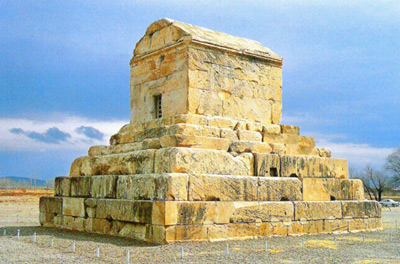Cyrus the Great, the founder of the Achaemenid dynasty
Biography of Cyrus the Great
Cyrus the Great (529-576 BC), also known as Cyrus II, is the first king and the founder of the Achaemenid dynasty. Cyrus the Great is known for his generosity, establishing human rights, establishing the first multinational and large empire in the world, freeing slaves and prisoners, respecting various religions and cults, expanding civilization, etc.
Iranians called Cyrus the great father and Greeks, whose lands he had conquered, called him lord and lawgiver. The Jews considered Cyrus the Great to be anointed by God, while the Babylonians considered Cyrus the Great to be approved by Marduk.
Cyrus the Great’s wife and children
Cyrus the Great chose a wife named Kasandan from the Achaemenid family, with whom he had 4 children. Two of the children of Cyrus the Great were boys and the other two were girls. The sons of Cyrus were named Cambojie II and Berdia, and one of his daughters was named Atusa, but the name of another daughter of Cyrus the Great is not mentioned in historical sources. After the death of his father, Cambyses II took the throne in his place and killed his other brother Berdia. After conquering Egypt, he committed suicide on his way back to Iran.
Atusa, the daughter of Cyrus the Great, also married Darius I and became the queen of Iran. Also, Cyrus the Great had another daughter named Artiston, who was not born from Kasandan and was Atusa’s half-sister. Kasandan and Cyrus the Great had a lot of love for each other, and Kasandan loved Cyrus the Great until his death. According to the inscription of Nabonidas in Babylon, when Kasandan died, all the people of the Achaemenid Empire mourned in honor of Cyrus the Great, and this mourning was especially evident in Babylon, and the people of this city mourned for 6 days (from March 21 to 26, 538). they were busy.
The tomb of Kasandan, the wife of Cyrus the Great, was located in Pasargad, the capital of the Pars Empire. Other sources provide other information about Cyrus’ wife. According to these sources, Cyrus the Great married the daughter of Aghidhag named Amitis. It is possible that after Cassandan’s death, Cyrus the Great married a Mede daughter of his royal family.
The period of power of Cyrus the Great
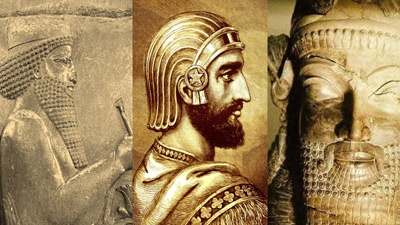
Cyrus the Great chose a wife named Kasandan from the Achaemenid family, with whom he had 4 children.
After Cyrus the Great became their king, he thought of attacking Medes. Meanwhile, Harpag played a major role. Harpagus incited the elders of the Medes, who were dissatisfied with the harshness and severity of the emperor’s actions, against Ishtovigo (Aghi Dahak) and succeeded in forcing Cyrus the Great to march against the Medes king and defeat him.
With the defeat of the Medes by Persia, which was a puppet country and a subject of it, the 35-year reign of Ishtovigo, the king of the Medes, came to an end, but according to Herodotus, Cyrus the Great did not harm Ishtovigo and kept him with him. In this way, Cyrus the Great took over the kingdom of Media and Iran in 546 and declared himself the king of Iran.
After Cyrus the Great united Media and Persia and called himself the King of Media and Persia, while Babylon had betrayed him, he wisely asked Qarun, Shah Lady, to recognize his rule and in exchange for Cyrus the Great to reign. Accept him as a lady.
But Qarun (Crouses) in the complete lack of wisdom, instead of accepting this proposal of Cyrus the great, he thought of expanding the borders of his country, and for this reason, he hurriedly crossed the river Halsi (modern-day Qazalirmaq in Turkey), which was the border between his country and the Medes. Seeing this hostile move, Cyrus the Great moved from Hamedan to Lydi, and Dejsard, which was considered impregnable, fell from its walls when a number of Iranian soldiers climbed and Qarun (Croesus), the king of Lydi, was captured by the Iranians, and Cyrus Kabir extended the border of his country to the Roman sea and the neighborhood of the Greeks.
The remarkable thing is the behavior of Cyrus the Great after the defeat of Qaroon. Cyrus did not kill or humiliate the defeated king Lady, but lived under the protection of Cyrus until the end of his life, and the people of Sardar were pardoned despite the fact that they had delayed Cyrus the Great’s army for three months in a state of war and under siege of their city. .
The goal of Cyrus the Great to campaign to the east
After Lady Cyrus the Great, he brought the eastern regions under his command, one after the other, and in order, Gorgan (Hirkani), Parth, Haryu (Herat), Rokhj, Merv, Balkh, Zarngiana (Sistan) and Sugod (areas between Amu Darya and Sir Darya). ) and subjugated Thatgush (northwest India).
The main goal of Cyrus the Great’s campaign to the east was to provide security and consolidate the position, otherwise there would not have been a government in the eastern side of Iran at that time that could fight with Cyrus the Great . By subduing the eastern regions of Iran, Cyrus the Great doubled the size of the territories under his control. Now the king of Babylon had really regretted his betrayal to Cyrus the Great and the promise he made to him at the beginning of his victory over Medes.
Of course, it goes without saying that one of the main reasons for the fear of the king of Babylon was Cyrus the Great’s reputation for having moral integrity and his popularity among the people of Babylon on the one hand, as well as the predictions of the prophets of Israel about the liberation of the Jewish people at the hands of Cyrus on the other hand. .
Cyrus the Great and the liberation of Darband Jews

The behavior of Cyrus the Great after the conquest of Babylon has a special place among archaeologists and even lawyers
Babylon fell without defense on the 22nd of October 539 BC and only the royal quarters resisted for a few days, the king was imprisoned and Cyrus the Great, as usual, treated him like a free secretary, and in the next year (538 BC) when When he passed away, national mourning was announced and Cyrus the Great himself participated in it. With the conquest of Babylon, its colonies, namely Syria, Palestine and Phenicia, also surrendered and were added to the domain of Cyrus the Great.
The behavior of Cyrus the Great after the conquest of Babylon has a special place among archaeologists and even lawyers. Cyrus the Great freed the Jews and, while returning all the property that Bakht al-Nasr (Nebuchadnezzar), the powerful king of Babylon, had taken from Solomon’s temple during the conquest of Jerusalem, he provided them with many financial and facilities so that they could return to Jerusalem and ordered He ordered the rebuilding of Solomon’s temple and because of this, he became known as a savior among the Jews, which is recorded in Jewish history and in the Torah.
Religion of Cyrus the Great
In Babylon and other places, many documents have been obtained in connection with the tolerance of Cyrus the Great in religious matters, and no signs of his prejudice against his national religion have been seen. There is disagreement about what religion Cyrus the Great had, and probably Cyrus himself must have been a worshiper of Ahura Mazda, although we know almost nothing about his beliefs.
According to Xenophon’s report, Cyrus the Great followed Mughan’s instructions in his court regarding religious issues. Although many scholars do not consider Cyrus the Great to be a Zoroastrian, Mary Boyce strongly argues that Cyrus himself was a Zoroastrian, following in the footsteps of his ancestors, who were still petty kings as early as the 7th century BC.
He points out that the fire temples and shrines of Pasargad indicate the practice of Zoroastrian rites and Greek texts also show that Zoroastrian monks had valuable positions in the court of Cyrus the Great.
Lewis Gray believes that Cyrus the Great was an exact follower of the ancient Iranian religion before the Zoroastrian Gathas and its remnants in the New Avesta, and the gods who were revered by Cyrus can be compared to Ahuramazda, Mitra, Azaru Anahita. He believes that the religion of Cyrus the Great was close to the religion presented in the New Avesta and there is no reason to consider him a Zoroastrian.
On the other hand, researchers such as George Cameron and Walter Hintz believe that Zoroastrian lived between 660 and 582 BC and that Cyrus the Great even met Zoroastrian during this period and was a follower of Zoroastrian religion, and the reason for this argument is the built fire pits. They know in the open space and the fire maintenance tower in Pasargad.
Max Malvan says that so far no evidence has been obtained on the basis of which it can be said that Cyrus the Great was a Zoroastrian, but Cyrus’s behavior has many common points with Zoroastrian teachings and the principles of his religion, and perhaps he was influenced by Zoroastrianism.
Cyrus the Great had two sons from his only wife, Kasandan, named Kambojie and Berdia, who chose Kambojie as his crown prince before his campaign to the east. Because of his appointment as the “King of Babylon”, Kambojie was practically designated as the successor of Cyrus the Great, and Cyrus left the affairs of the country to him. Probably, after the death of his father, Cyrus the Great, Cambogia organized the northeastern borders and in the fall of 528 BC, he started an attack on Egypt and was able to conquer it.
Death of Cyrus the Great
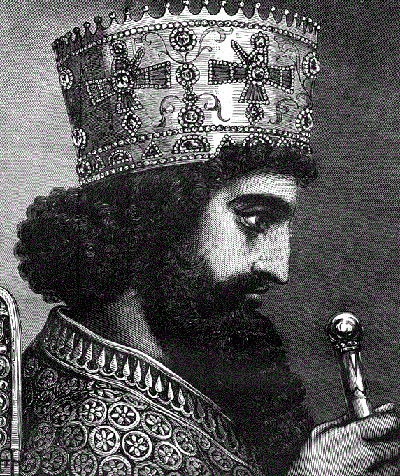
After the death of Cyrus the Great, his son Cambyses II (Cambyses II) was chosen as the king
Regarding the death of Cyrus the Great, the narrations are very confusing and different from each other. According to the historical book of Herodotus, which contradicts the archeological findings in many areas and many contradictions can be seen in it, Cyrus the Great was killed in a war with the Massaget tribes, who were yellow-skinned tribes living in the north of Khorasan.
According to the traditions of Herodotus, the Massaget tribes in the southern regions of Khwarezm and Qezil Qom, which are today part of the steppes of modern Kazakhstan, started a war with Cyrus the Great after he attacked that region. The relatives of the Massaget were capable horsemen who lived on horseback.
In order to obtain the territory of the ruler of these tribes, who was a woman named Tomyris, Cyrus the Great proposed marriage to him, but Tamiris rejected this proposal, so Cyrus the Great decided to seize these territories by resorting to force and military force. brought He crossed this river by providing boats and ships from Jaxartes river (Sir Darya) across the river.
Then Cyrus the Great sent an envoy to Tamiris and warned him that if he did not respond to his request, he would have to wait for dire consequences. Tamiris replied to Cyrus that they would see each other on the battlefield.
The armies of the two sides met each other at a place that was one day’s distance from the Sir Darya river. Cyrus the Great was told that the Massagets are strangers to wine and do not know it and are unaware of the intoxication caused by drinking wine. Cyrus the Great left a large amount of wine and provisions in his camp and left the camp with his men. The commander of Tamiris’ army was none other than his son Spargapis.
Spargapis attacked the camp of Cyrus the Great with his army and found the camp full of food and a strange drink. The massages quickly began to eat and drink and drank a large amount of food and wine. When they were overcome by drunkenness, Cyrus the Great attacked this army with his men.
During this attack, Spargapis was captured by Cyrus the Great and committed suicide when he got drunk and regained consciousness. When Tamiris was informed of what had happened, he denounced this tactic of Cyrus the Great as uncouth.
He ordered the second wave of attack to be carried out by his men against the Persian forces and he himself took command of this attack. In this attack, Cyrus was killed and his army suffered many casualties. Tamiris ordered to avenge his son’s blood by cutting off the head from the body of Cyrus the Great and putting it in a pan full of blood and saying to Cyrus’ head: You who could not get enough of eating blood, now eat as much blood as you like.
This narrative of Herodotus is very similar to a legend from the point of view of historians, and no other historian than Herodotus has defined this narrative. Historians believe that this account was known as an unreliable account by Herodotus, but he included this account in his book.
At the time of Cyrus the Great’s death, the Achaemenid Empire was the largest empire that mankind had ever seen. This empire included an area from Central Asia in the north and a part of today’s Pakistan in the east to the Persian Gulf in the south and a part of today’s Greece in the west.
Legacy of Cyrus the Great
After the death of Cyrus the Great, his son Cambyses II (Cambyses II) was chosen as the king. Before going to Egypt to conquer that country, Kamboja II killed his brother Berdia and then marched to Egypt. After conquering Egypt, he sat on the royal throne and introduced himself as the son of the gods, but some time later he killed the sacred cow of the Egyptians.
Some people believe that he did this because he was suffering from insanity and some people believe that it was because of preventing the ignorance of the people and worshiping the cow because according to the beliefs of Cambyses, who was a monotheist and worshiper of Yazdan, the cow was not considered a sacred creature.
While he was in Egypt, a sorceress, whose brother closely resembled Berdias, the murdered brother of Cambyses, was introduced to the royal palace by that sorceress. This person, whose name was Geomate, introduced himself as Berdia, the son of Cyrus the Great, and sat on the throne. When this news reached Cambyses, he moved from Egypt to Iran, but committed suicide in present-day Syria.
After the death of Cambyses, the son of Cyrus the Great, and the disclosure of Geomate’s secret, a group of 7 Achaemenid princes attempted to kill Geomate and his brother in the royal palace, and one of these 7 people named Darius the Great sat on the throne. Darius, who was considered one of the cousins of Cyrus the Great, after coming to power expanded the country of Persia and fought with the Greek army in a battle called Marathon, but was defeated. Although today, the issue that the Iranian army was defeated in this war is doubted by a number of places.
During the time of Darius, the Persian army advanced to the Balkan Peninsula, and after the death of Darius, his son Khashayar Shah came to power. King Xerxes attacked Greece with a massive army that history had never seen before, and although he was defeated in the Battle of Salamis, he succeeded in capturing Athens, the capital of Greece. This conflict continues whether the Iranians intentionally set it on fire or not.
The Achaemenid Empire was overthrown by the invasion of Alexander the Great in 331 BC, and Darius III was its last king. Although some still believe that Alexander’s attack on Iran lacks any historical truth.
The Achaemenid Empire, by occupying Egypt in Africa and occupying parts of the Balkans, practically became the only empire in the world that had territory in three continents of the world at that time, and although later the Romans also gained the possibility to expand in all three continents of the world that day. But the Achaemenid Empire was the first empire to penetrate all three continents.
During his lifetime, Darius the Great ordered the construction of Persepolis or Persepolis and chose it as the capital of the Achaemenids with the construction of magnificent palaces and called himself Shahneshah (Shah of Kings). The glory of this city was so great that foreign ambassadors and merchants of other countries were amazed after entering it.
Also, Dariush has a very interesting prayer for Iran in an inscription that is referred to by many Iranians even today. In this inscription, he prays for Iran like this: May God protect this country from lies, enemies and drought. During the time of Darius, the construction of Persepolis was founded, where many palaces were built and soldiers of the Immortal Guard were assigned to protect those palaces.
Dariush also ordered the construction of many roads in order to expand trade in his time, one of the most famous of which is the Shahi Road that ran from Susa to Sard. To protect these roads, he built forts along these roads and increased trade security.
By building roads, the trade between East and West was facilitated through the Achaemenid Empire because the Silk Road, which was a way through which goods such as silk were exported from the Far East and China to Europe (Greece and later Rome), due to the creation of security And the construction of the road increased a lot and Iran became a bridge between the West and the East and caused the expansion of human culture and civilization. Dariush also created the world’s first postal system.
He ordered that post offices be built along the roads, and the couriers who were carrying letters would deliver the letter to another courier who was ready to serve after traveling a distance in these post offices. After traveling a distance, this courier would give the letter to the next courier at the next post office, and in this way, the tired courier and horse would always be replaced by a fresh courier and horse. This would make Dariush get to know the news much earlier than other rulers of the world.
Cyrus the great cylinder
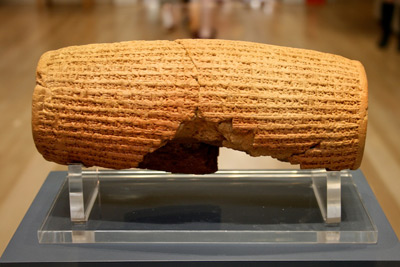
Cyrus the great cylinder
The only relatively detailed document left of Cyrus the Great is a 22.5 cm long and 11 cm wide clay cylinder with a 45-line inscription in Babylonian, which is kept today under the number 90920 in room 52 of the Ancient Iran section of the British Museum.
The main piece of Cyrus the Great’s cylinder was found in 1879 by Hormuzd Rasam in the excavation of Marduk’s temple in Babylon. This piece of Cyrus’ cylinder contained 35 lines. The second fragment of the Cyrus cylinder, which includes lines 36 to 45, was found in the Babylon Collection of Yale University in 1975 and was attached to the original cylinder.
In 1971, the United Nations published the cylinder of Cyrus the Great in all the official languages of the organization, and instead of this cylinder, it was placed in the UN headquarters in the space between the main hall of the Security Council and the Guardian Hall in New York City. In this place, there is an example of cultural works of different countries.
Tomb of Cyrus the Great
Tomb of Cyrus the Great
He placed the tomb of Cyrus the Great at a distance of about one kilometer southwest of Pasargad palaces. The Tomb of Cyrus the Great was registered as a UNESCO World Heritage Site in 2004 as a subset of Pasargad under number 1106.
The tomb of Cyrus the Great is located on a high platform, which is also made of carved pieces of stone. On top of the platform there is a room for burial. This room is 2.10 meters wide, 3.17 meters long and 2.10 meters high. Its entrance is small and narrow.
The tomb of Cyrus the Great is covered by triangular-shaped gable stones, the total height of the building is about 11 meters. The overall height of Cyrus the Great’s tomb is slightly more than 11 meters. The first platform, which forms the first step, is 165 cm high, but about 60 cm of it was originally uncut and hidden, that is, it was exactly 105 cm high, like the second and third steps. The fourth, fifth and sixth stairs are 57.5 cm high each. The width of the platforms is half a meter, and the surface of the sixth platform, which forms the base of the tomb of Cyrus the Great, is about 6.40 meters by 5.35 meters.
The tomb of Cyrus the Great, which was most likely built before his death and by his own command, was considered sacred throughout the Achaemenid period and was well maintained. In the Islamic period, this building was known as “Mashad of the Mother of Suleiman” and the first person who realized that the Mashhad of the Suleiman is the tomb of Cyrus the Great was the English traveler and diplomat Robert Corporter who visited Pasargad in 1818.
Zulqarnain
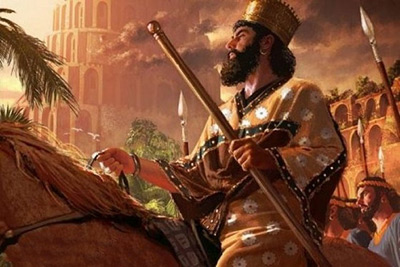
There is a difference of opinion about the religion of Cyrus the Great
About the character of Dhul-Qarnain, which is mentioned in the divine books of Jews, Christians and Muslims, there are many things, and it has not been definitely determined who Dul-Qarnain really is.
Cyrus the Great of the Achaemenid dynasty, Darius the Great, Xerxes, Alexander the Great are options that have been investigated in order to find the real Dhul-Qarnain, but according to the historical documents and their comparison with the verses of the Quran, Torah, and the Bible, Cyrus the Great is the only one who It has the most valid reasons for obtaining this title. A number of contemporary Shia jurists also consider Cyrus the Great as Dhul-Qarnain. Ayatollah Tabatabaei, Ayatollah Makarem Shirazi and Ayatollah Sanei are believers of this opinion.
The crown prince and successor of Cyrus the Great

